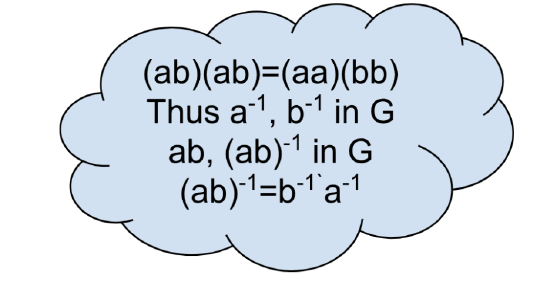2.2: Properties of Group Elements
- Page ID
- 131256
Let \((G, \ast)\) be a group. Then
-
The identity is unique,
-
For each \(a \in G\), one and only one inverse exists.
-
For each \(a \in G, \ (a^{-1})^{-1}=a\).
-
\((a\ast b)^{-1}=b^{-1} \ast a^{-1}, \forall a,b \in G.\)
Note if \(G\) is abelian,\((a\ast b)^{-1}=b^{-1} \ast a^{-1}=a^{-1} \ast b^{-1}, \forall a,b \in G\).
5. If \(xy=xz, \forall x,y,z \in G\), then \(y=z\). (Left cancellation)
6. If \(yx=zx, \forall x,y,z \in G\), then \(y=z\). (Right cancellation)
- Answer
-
Proof:
Let \((G,\ast)\) be a group.
1. We shall show that identity is unique.
Assume that \(G\) has two identity elements, \(e_1\) and \(e_2\).
Thus \(a \ast e_1=e_1 \ast a=a\) and \(a \ast e_2=e_2 \ast a=a\), \(\forall a \in G\).
We will show that \(e_1=e_2\).
Consider \(e_1 \ast e_2=e_2 \ast e_1 =e_1\) and \(e_2 \ast e_1=e_1 \ast e_2 =e_2\).
Thus since \(e_1=e_2\), the identity is unique.◻
2. We shall show that for each \(a \in G\), one and only one inverse exists.
Let \(a \in G\).
Assume that \(a\) has two inverses, \(b\) and \(c\).
Then \(a \ast b=b \ast a=e\) and \(a \ast c=c \ast a=e\).
We shall show that \(b=c\).
Consider \(b=b \ast e\)
\(=b \ast(a \ast c)\)
\(=(b \ast a) \ast c\)
\(=e \ast c\)
\(=c\).
Thus \(b=c\) and for each \(a \in G\), there exists one and only one inverse.
3. We shall show that for each \(a \in G, \ (a^{-1})^{-1}=a\).
Let \(a \in G\). Then \(a \ast a^{-1}=a^{-1}\ast a=e\).
Thus \((a^{-1})^{-1}=b^{-1}=a\).
Assume that \(G\) has two identity elements, \(e_1\) and \(e_2\).
Thus \(a \ast e_1=e_1 \ast a=a\) and \(a \ast e_2=e_2 \ast a=a\), \(\forall a \in G\).
We will show that \(e_1=e_2\).
Consider \(e_1 \ast e_2=e_2 \ast e_1 =e_1\) and \(e_2 \ast e_1=e_1 \ast e_2 =e_2\).
Thus since \(e_1=e_2\), the identity is unique.◻
4.
Let \(a,b \in G\).
Then \(a \ast b \in G\), \(a^{-1} \in G\), \(b^{-1} \in G\) and \(a \ast b \in G\).
Consider \((b^{-1} \ast a^{-1})(a \ast b)= b^{-1} \ast (a^{-1}a) \ast b)\)
\(=b^{-1}\ast e \ast b\)
\(=b^{-1}\ast b\)
\(=e\).
And consider \((a \ast b)(b^{-1} \ast a^{-1})=a \ast ( b^{-1} \ast b) \ast a^{-1}\)
\(=a^{-1}\ast e \ast a\)
\(=a^{-1}\ast a\)
\(=e\).
Since \((b^{-1} \ast a^{-1})(a \ast b)=e= (a \ast b)(b^{-1} \ast a^{-1})\), then \((a\ast b)^{-1}=b^{-1} \ast a^{-1}, \forall a,b \in G\).◻
5.
Let \(x,y,z \in G\) s.t. \(xy=xz\).
Note: \(x^{-1} \in G\) since \(G\) is a group.
Thus \(x^{-1}(xy)=x^{-1}(xz)\)
Thus \((x^{-1}x)y=(x^{-1}x)z\) since associative.
Thus \(ey=ez\) and \(y=z\).◻
6.
Let \(x,y,z \in G\) s.t. \(y \ast x=z \ast x\).
Note: \(x^{-1} \in G\) since \(G\) is a group.
Thus \((y \ast x) \ast x^{-1}=(z \ast x) \ast x^{-1}\)
Thus \(y \ast (x^{-1} \ast x)=z \ast (x^{-1} \ast x)\) since associative.
Thus \(y \ast e=z \ast e\) and \(y=z\).◻
Let \(G\) be a group.
Let \(g,h \in G\) and \(m,n \in \mathbb{N}\).
Then
-
\(g^m \ast g^n=g^{m+n}\) where \(g^m=g \ast \cdots \ast g\). Note there would be \(m\) \(g\)’s.
-
\((g^m)^n=g^{mn}\).
-
\((gh)^{-m}=(h^{-1} g^{-1})^m\).
With the addition operation \(g^m=mg.\)
Let \(G\) be a group and suppose that \((ab)^2=a^2b^2\) for all \(a\) and \(b\) in \(G\). Prove that \(G\) is an abelian group.
Solution

Let \(G\) be a group.
Let \((ab)^2=a^2b^2, \; \forall a,b \in G\).
We shall show that \(G\) is abelian.
Let \(a,b \in G\).
We shall show that \(ab=ba\).
Note that \((a \star b)\star (a \star b)= (a \star a) \star (b \star b)\).
Consider that \(a^{-1} \star (a \star b) \star (a \star b)\star b^{-1}=a^{-1} \star (a \star a) \star (b \star b) \star b^{-1}\).
Then \((a^{-1} \star a) \star b \star a \star (b \star b^{-1})=(a^{-1} \star a)\star a \star b \star (b \star b^{-1})\).
Thus \(e \star b \star a \star e=e \star a \star b \star e\).
Thus \(b \star a=a \star b\).◻
Note: Operator * included for students.


